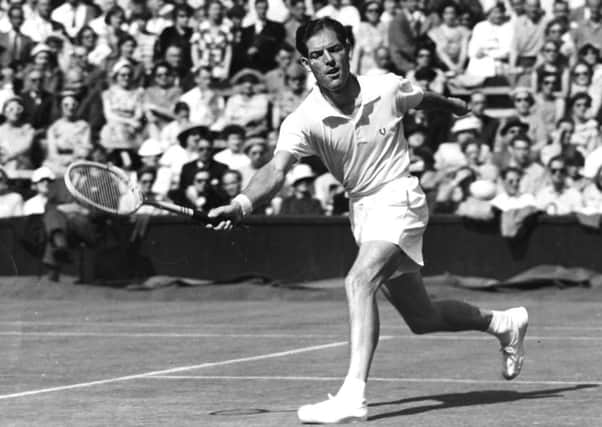Obituary: Tony Mottram, tennis player appointed GB national coach in 1970s


In an age when it was thought ungentlemanly in tennis society to spend too much time practising, Tony Mottram would get up at 6.30 in the morning and train for a couple of hours before going to school.
Inspired by Fred Perry – now a British tennis legend, but then another working-class outsider, Mottram went on to become a champion in his own right, the British number one, a stalwart of the Davis Cup team and later the GB national coach.
Advertisement
Hide AdAdvertisement
Hide AdHe reached the Wimbledon singles quarter-finals in 1948 and he was runner-up in the doubles the previous year. He had made his Wimbledon debut in 1939, but his career was interrupted by the Second World War – in which he served with great distinction, as a pilot, based in Scotland.
His career was also adversely affected by class prejudice within the sport and the division between the amateur and professional ranks. Mottram played at a time when many greats, including Perry, Pancho Gonzales, Ken Rosewall and Rod Laver, turned professional and found themselves barred from Wimbledon and the other major tournaments until the advent of “open tennis” in 1968.
Mottram and his wife Joy Gannon, who was also an international-class player, turned professional in the 1955, when Mottram was still winning matches at Wimbledon. Subsequently they played exhibition matches, but mainly earned their living through coaching. Mottram was appointed GB national coach in the 1970s and demanded total dedication from his players, which led to friction with some.
His coaching methods certainly paid off when it came to his own children, Linda, who was national junior champion, and Christopher, known as Buster, who made it into the world top 20 in the 1980s – although his achievements on court were overshadowed by his notoriously right-wing politics and support for the National Front. He was later expelled from UKIP.
A salesman’s son, Anthony John Mottram was born in Coventry in 1920. He won a scholarship to a local private school and by his early teens was balancing academic work and his growing passion for tennis.
By 17 he was playing in major English tournaments. He had just turned 19 when he made an impressive debut at Wimbledon in June 1939, reaching the third round.
With the outbreak of the Second World War it would be another seven years before he managed a second appearance. He joined the RAF, trained as a pilot and won the DFC, Distinguished Flying Cross, for a successful attack on enemy shipping, while under heavy fire, in the North Sea. Latterly he was station adjutant at RAF Banff.
At the end of the war he successfully picked up his tennis career where he had left off, returning to Wimbledon and making his Davis Cup debut in 1947 in a victorious tie in the ruins of Warsaw. “The city was in a terrible state, with rubble everywhere,” he later recalled.
Advertisement
Hide AdAdvertisement
Hide AdHe had a good all-round game and had a decent record on the French Open clay, as well as Wimbledon’s grass. He played in 19 Davis Cup ties, both in singles and in doubles, winning more rubbers than he lost. Only five British players, including Perry, Tim Henman and Andy Murray, have a better record than his 36-20.
His regular Davis Cup doubles partner was Geoff Paish. Not only did Paish’s son John also become a successful professional player, but John Paish and Buster Mottram made history in the 1970s when they became the first Davis Cup doubles pairing who were the sons of a previous Davis Cup doubles pair.
Mottram married Joy Gannon, who was also a British international tennis player. She shares her surname with a well-known tennis family in East Lothian – they run a sports shop in Gullane, but the Scottish Gannons do not know of any family connection. Joy was a colourful character on the tennis circuit, invoking the displeasure of the All England Club when she wore an outfit with a purple trim one year.
In the mid-1950s, professional players were ostracised by the upper classes who ran the game and could use family money or other income to support themselves while playing the game at a high level.
Perry became a virtual pariah when he turned professional and Mottram was stripped of his All England Club membership, albeit that they relented and gave him an honorary membership a few years later.
Mottram’s rehabilitation was completed after tennis opened its doors to professionals and he was appointed GB national coach in the 1970s. He claimed that British tennis was still suffering from the attitude that to take the sport too seriously was ungentlemanly and insisted players had to be tougher and more disciplined.
“My definition of a tennis genius is ‘a talented player who will work’,” he wrote in an article. “I am convinced that most juniors (and their parents) in this country fail to appreciate how hard they must work.”
Mottram wrote about tennis for several English newspapers and he and his wife also wrote several books on how to play the game. He is survived by his wife, his children Buster, Linda and another daughter Karen, who seemed to evade the tennis net.
BRIAN PENDREIGH